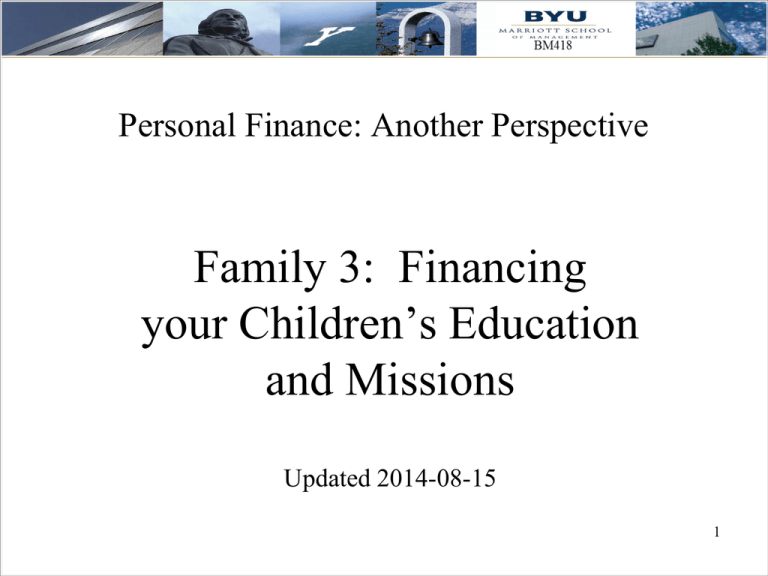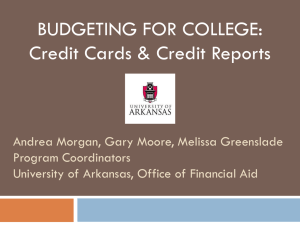Financing Education and Missions
advertisement

Personal Finance: Another Perspective Family 3: Financing your Children’s Education and Missions Updated 2014-08-15 1 Objectives A. Understand how education relates to financial goals B. Understand the principles of financing education and missions C. Understand the priority of money for financing school and missions D. Understand how to save for your children’s education E. Understand how to save for your children’s missions F. Understand how to reduce the cost of 22 education and apply for aid A. Understand How Education Relates to Financial Goals Median Level of Education Annual Earnings* Lifetime Earnings Not a HS graduate $24,325 $973,000 High school Diploma 32,600 1,304,000 Some College, no degree 38,675 1,547,000 Associate's Degree 43,175 1,727,000 Bachelor’s Degree 56,700 2,268,000 Master’s Degree 66,775 2,671,000 Doctoral Degree 81,300 3,252,000 Professional Degree 91,200 3,648,000 *Annual earnings is lifetime earnings divided by 40 years. Source: Anthony P. Carnevale, Stephen J. Rose, and Ban Cheah, “The College Payoff: Education, Occupations, Lifetime Earnings,” Georgetown University Center for Education and the Workforce, 2012. 33 Does Education Pay? • Is education a good investment? • President Gordon B. Hinckley said: • Now is the season to train your minds and your hands for the work you wish to do. Education can prove to be the wisest and most profitable investment you will ever make (Tambuli, Sept. 1989, 49). • He further counseled: • Get all the schooling you can. Education is the key that unlocks the door of opportunity. God has placed upon this people a mandate to acquire knowledge “even by study and also by faith” (D&C 88:118) (“Some Thoughts on Temples, Retention of Converts, and Missionary Service,” Ensign, Nov. 1997, 49). 44 Is Education Cheap? • Cost Facts: • Average NR U.S. medical school tuition/fees in 20132014 was $55,294 (public) and $52,093 (private) • 2014 average top 20 MBA programs tuition and fees: >$100,000 (varies by school) • Average cost in tuition, fees and lost salary: $150,000 • Annual budget for students of BYU in 2014-2015 • Undergraduate $17,882 (LDS), 22,882 (non-LDS) • Graduate $25,926 (LDS), 33,236 (non-LDS) • MSM/Law $32,020 (LDS), 43,640 (non-LDS) • Education isn’t cheap, but the cost of ignorance is higher!5 5 Should You Pursue an Education? President Hinckley said: • You young people, the little decisions that you make can so affect your lives. Shall I go to school or not? Shall I continue on with my education? That is a big decision for some of you. Our doctrine suggests, although there may be some circumstances that would affect that decision, that the more education you receive the greater will be your opportunity to serve. That is why this Church encourages its young people to get the schooling that will qualify them to take their places in the society in which they will become a part. Make the right decisions. Take a long look (Pocatello, Idaho, regional conference, Idaho State University, 4 June 1995). 66 Should Children Pursue an Education? President Hinckley further commented: It is so important that you young men and you young women get all of the education that you can. The Lord has said very plainly that His people are to gain knowledge of countries and kingdoms and of things of the world through the process of education, even by study and by faith. Education is the key which will unlock the door of opportunity for you. It is worth sacrificing for. It is worth working at, and if you educate your mind and your hands, you will be able to make a great contribution to the society of which you are a part, and you will be able to reflect honorably on the Church of which you are a member. My dear young brothers and sisters, take advantage of every educational opportunity that you can possibly afford, and you fathers and mothers, encourage your sons and daughters to gain an education which will bless their lives (Gordon B. Hinckley, “Inspirational Thoughts,” 77 Liahona, June 1999, 3). B. Understand the Principles of Financing Education and Missions • Principles of financing education and missions: 1. Teach your children to be financially responsible 2. Help your children to contribute to their own and other family member’s missions and education 3. Develop an education and mission plan that is consistent with your personal goals and budget and then follow it 4. Start saving early for your children’s education and missions 5. Invest wisely and tax-efficiently 88 Principles (continued) 1. Teach your children to be financially responsible • Teach them to work and to earn, consistent with their age and abilities • Teach them to share the things they have—none of it belongs to us • Teach them to be accountable for their spending • Teach them that they earn money based on their working—not their whining 99 Principles (continued) 2. Help your children to save for their own (and other family member’s) education and missions consistent with their abilities to earn • Encourage your children to set savings goals where they can save for their own missions and education • Set up investment or savings accounts for your children, and contribute their savings to these accounts • Give your children opportunities to earn money that is earmarked, after paying the Lord, specifically for their missions and education 10 10 Principles (continued) 3. Develop education and mission plans for your children consistent with your personal goals and budget, and then follow them • Develop an education plan to help save for your children’s education • Develop a mission plan to help save for your children's missions • Encourage your children to participate. Plans which require work and contributions by children have a better chance of teaching the principles discussed • Share these plans with your children early 11 11 Principles (continued) 4. Start NOW and early to save for your children’s education and missions • The best time to begin saving for your children’s education and missions is now • Begin now and begin early • Have your children begin saving for their missions as well • Encourage them to contribute to their siblings or other family members missions 12 12 Principles (continued) 5. Invest wisely and tax-efficiently • Use wisdom in your investments • Follow the priority of money discussed earlier • Think through carefully and write a good investment plan for these assets – then follow that plan 13 13 C. Understand the Priority of Money for Education and Missions • Is there a priority of money for financing education and missions? • Priority of Money for Educations and Missions 1. Free Money 2. Family Money 3. Employment 4. Loans 5. Credit Cards (No!) 6. Retirement Accounts (No!) 14 14 1. Free Money • Get free money first--scholarships and grants ◦This is free money which is not paid back • If you have to pay money to get a scholarship or grant, it is generally a scam! ◦ Grants are need-based--complete the FAFSA • Pell Grant: approximately $602-$5,730/year in 2014-2015 • SEOG Grants – not available at BYU ◦ Scholarships from schools and private sources • You may need a supplemental application • Find out which ones you are eligible for on a scholarship search engine and apply for each ◦ Armed Forces Scholarships: See recruiting offices 15 15 2. Family Money • Use personal savings and help from parents ◦ If children pay for their education and missions, they will likely use their resources more wisely, as it’s their money they are spending. • Start the process of financial self-reliance as soon as you can. • Do as much as you can to help your children, but don’t do it all ◦ If parents and grandparents can help, that is wonderful. • Express appreciation to anyone who helps! 16 16 3. Employment Have children work when possible to offset educational expenses ● • Most colleges offer federal College Work Study. Some universities, including BYU, provide thousands of student employment opportunities from their own funds. • Undergraduate students enrolled in 12+ semester hours should work no more than 20 work hours per week. This may cover rent and food expenses. • BYU students who work full-time at $10/hr while living free at home for 4 months will earn tuition for two semesters. • High school students should work no more than 0-10 hours per week while in school. Working more hours reduces GPA and likelihood of attending college. It also increases likelihood of promiscuity, drug abuse and alienation from family and faith. • Working summers to save for mission and college is desirable. 17 17 4. Loans • Use (all) loans wisely ◦ There are five main items to be aware of: a. Who pays the interest during school? •The borrower or the government? b. When must you start paying back the loan? • Immediately or after graduation? c. Who takes out the loan? • You or your parents? d. What is the interest rate cap? • What is the highest rate you may pay? e. What are the amounts available and costs? • What are all the costs: fees, interest, etc.? 18 18 Loans (continued) • Subsidized Loans (2014-2015) ◦ Subsidized Federal Loans • Direct Subsidized Loans (direct from Federal government—undergraduates only) a. Government pays interest while student is enrolled in school at least half-time b. Repayment begins 6 months after student graduates or drops below half-time enrollment • The 6-month grace period is preserved and starts over at zero if the student returns to half-time enrollment before the 6 months expire, therefore the student controls when repayment begins 19 19 Loans (continued) • Direct Subsidized Loans (continued) c. Loan is in the student’s name d. For 2014-2015, the interest rate is fixed at 4.66%. No interest accrues (grows) while enrolled in school at least half-time. Thereafter, simple interest accrues at 4.66% APR e. Direct Subsidized Loan amounts range from $100 to $5,500 (for undergraduates only). f. 1.072% origination fee applies 20 20 Loans (continued) • Subsidized Loans ◦ Subsidized University Loans: • Woolley Law Loan (BYU Law School) • For full-time law students as approved by the law school (usually for externships or bar study courses) a. Interest is 5.5% fixed for 120 months, and no interest is paid while in school b. Payments and interest begin 9 months after graduation or discontinuance of full-time status c. Loans are in the student’s name d. Credit check required 21 21 Loans (continued) • Marriott School Loan (BYU Marriott School of Management) for full-time MSM graduate students a. No interest is paid while in school b. Payments and interest begin 6 months after graduation or discontinuance of full-time status c. Loans are in the student’s name d. Interest rate is 5.5% fixed for 60 months • Credit check required 22 22 Loans (continued) • Subsidized Loans ◦Subsidized University Loans (2014-2015): • BYU Short-Term Loans for Tuition ▫For part- and full-time students admitted to a degree-seeking program a. Must be repaid within the same semester loan is received b. Loans are in the student’s name c. No interest, but a $20 fee is applied 23 23 Loans (continued) • Unsubsidized Loans (2014-2015) ◦Unsubsidized Federal Loans • Direct Unsubsidized Loans (for both grads and undergrads) a. Student responsible for interest during school b. Repayment begins six months after student graduates, discontinues, or drops below half-time enrollment for a continuous 6 months c. Loan is in student’s name d. Fixed interest rate of 4.66% for undergraduates, and 6.21% for graduates e. 1.072% origination fee applies f. Maximum amounts $12,500 for undergraduates and $20,500 for graduates 24 24 Loans (continued) • Unsubsidized Loans ◦Unsubsidized Federal Loans • Direct PLUS Loan: Available for parents of undergraduate, dependent students to help with school-related expenses. a. Parent is responsible for interest during school b. Repayment begins six months after student graduates, discontinues, or drops below half time c. Parent is the borrower d. Interest rate is 7.21% fixed APR charged from first disbursement e. There is an origination fee 4.288%, a credit check for approval, and a FAFSA is required. Parents can borrow up to cost of education less financial aid the student receives 25 25 Loans (continued) • Unsubsidized Loans ◦ Direct Unsubsidized Federal Loans • Grad PLUS Loan: Available for graduate students to help with school-related expenses a. Student is responsible for interest during school b. Repayment begins six months after student graduates, discontinues or drops below half time c. Graduate student is the borrower d. Interest rate is 7.21% fixed APR charged from first disbursement e. Requires a credit check for approval, FAFSA, and a 4.288% origination fee. Student can borrow up to cost of education less financial aid the 26 26 Loans (continued) • Unsubsidized Loans • ◦Private Alternative Loans Caution -- these unsubsidized loans are much more expensive than federal unsubsidized loans • a. Interest starts immediately and accrues • b. Must begin paying the loan back immediately • c. Student is the borrower • d. Interest rates are higher than Federal loans and there is no interest rate cap. A 14.5% variable interest rate means loan amount can double in five years (Rule of 72) • e. These have higher up-front fees and may require a cosigner. Read the fine print VERY CAREFULLY 27 27 Loan Comparison Federal Direct Loans Private – Alternative •Subsidized 4.66% fixed * •Unsubsidized 4.66%* or 6.21%** fixed ◦ Like a credit card •Principle: ◦ Federal Stafford, PLUS, Grad PLUS = Less Costly •14.5% variable •Double in 5 years •Unsubsidized only ◦ Like a credit card •Principle: ◦ Private = More Costly •APR limit = 25% to Infinity Note: *=undergraduate ** = graduate 28 Loans (continued) • General rule: federal loans are generally less expensive than private, non-federal loans and a better choice if borrowing is necessary ◦ Federal loans enjoy some tax-payer subsidy and have flexible repayment options ◦ Beware of aggressive marketing campaigns of private-alternative loans • These are very expensive and often catch the unprepared or unaware 29 29 Federal Grants and Loans • Federal Financial Aid Options ◦ Federal grant and loan recipients must: • Be a citizen, permanent resident, or eligible non-citizen with a valid social security number • Have a high school diploma, (GED), or its equivalent • Be admitted as a regular student in an eligible degree or certificate-seeking program • Register or have registered for Selective Service for males • Complete the Free Application for Federal Student Aid (FAFSA) 30 30 Federal Loans and Grants (continued) • Additional requirements for Pell and Direct Loans: ◦ Be making satisfactory academic progress (SAP), ◦ Not be in default on a federal student loan or grant ◦ Additional requirements for Pell and Direct Loans: • Pell Grant Eligibility ◦ Not already have a baccalaureate degree • Direct Loan Eligibility ◦ Undergraduates and graduates; also postbaccalaureate students enrolled in courses required for admission to a graduate program or enrolled in a program leading to a certificate, may be awarded for up to one year 31 31 Federal Loans and Grants (continued) • Individual Development Accounts (IDA) ◦ Matching resources from local and other sources to encourage saving (2014 limits apply): • Match $3 (up to $4,500) for each $1 you save ◦ You save $1,500 max. ($15-62.50/month) ◦ They give $4,500, the total $6,000 • Must use for education, or home purchase, or to start a business • Must be in the program for 12 to 36 maximum • Must attend basic money management class (BM418), reside in Utah, be 18 or older, have income to save and meet needs criteria. For information, see www.uidan.org or (877) 787-0727 32 32 Federal Loans and Grants (continued) • IDA Limits ◦ The following are income eligibility by family size. Participants must have no more than $10,000 in net assets excluding one car and one house (2014) Family Size 1 2 3 4 Income $23,340 $31,460 $39,580 $47,700 Family Size 5 6 7 8 Income $55,820 $63,940 $72,060 $80,180 Proceeds may be used to purchase one of 4 productive assets: first homes, business start-up, post secondary education including vocational training, and assistive technology for work related activities 33 33 5. Credit Cards (No!) • Credit Cards and Payday Loans ◦ Among the most expensive way to borrow • They require you to pay it back immediately • There is no help in the payment of interest • The interest rates are extremely high and you are in school ◦ These are not advisable ways to finance schooling and are usually the result of poor planning!!! 34 34 6. Retirement Accounts • Taking money from retirement accounts is NOT NOT NOT NOT NOT recommended to help pay for your children’s education • (Do you get the hint?) • Your first priority is to save for retirement for you and your spouse • Then and only then, if resources are available, to help your children with their education • Try to find other alternatives. This is expensive, not tax efficient, and is not a good option to even think about 35 35 D. Understand How to Save for Your Children’s Education • College Savings Plans ◦ Five major ways to save for college: • With tax benefits 1. Series EE and Series I Government bonds 2. Education Savings Account (Education IRA) 3. 529 Prepaid Tuition Plan 4. 529 Savings Plan • No tax benefits 5. Tax-Efficient Investing 6. Custodial Accounts (UGMA/UTMA) 36 36 1. Series EE and Series I Bonds • Advantages: • Earnings are tax-free if used for paying tuition and fees (I bond rates are 1.94% and EE bonds are 0.5% until October 31, 2014) • Earnings are not taxed until bonds are cashed • Can be purchased in small denominations • Disadvantages: • 3-month penalty on early withdrawal before 5 years, with minimum holding period of 1 year • $10,000 per year maximum purchase per year per SSN (and $5,000 more if use your tax refund) • For tax-free status, principle and earnings can only be used for tuition and fees, not other expenses 37 37 EE/I Savings Bond Phase-out Limits • If your income is above specified limits in the year bonds are cashed, you cannot exclude the interest income from your income taxes. The limits are: Year 2010 2011 2012 2013 2014 Filing Single $70,100-85,100 $71,100-86,100 $72,850-87,850 $74,700-89,700 $76,000-91,000 Married Filing Jointly $105,100-135,100 $106,500-136,500 $109,250-139,250 $112,050-142,050 $113,950-143,950 • Your modified Adjusted Gross Income is your adjusted gross income adding back certain items such as foreign income, foreignhousing deductions, student-loan deductions, IRA-contribution deductions and deductions for higher-education costs. 38 38 U.S. Series EE Bonds/I over Time 39 39 2. Coverdell Education Savings Account • Advantages: • Distributions are tax-free (even beyond 2014). • You choose your investments. • Can be used for eligible elementary, secondary and post-secondary education expenses. • Disadvantages • Contribution limits of $2,000 per year in 2014, which may phase out as your income (MAGI) increases beyond specific limits ($95-110k single, $190-220k married filing jointly). • Funds must be used by age 30 (but can be transferred to other students). Earnings not used for educational expenses are taxed with a 10% penalty 40 40 Coverdell Deductibility Limits Education IRA MAGI Phase Out Range (in 000’s) Year Amount Single Range Married FJ Range 2010 $2,000 $95-$110 $190-$220 2011 $2,000 $95-$110 $190-$220 2012 $2,000 $95-$110 $190-$220 2013 $2,000 $95-$110 $190-$220 2014 $2,000 $95-$110 $190-$220 • Your Modified Adjusted Gross Income is your adjusted gross income and adding back certain items such as foreign income, foreignhousing deductions, student-loan deductions, IRA-contribution deductions and deductions for higher-education costs. Earnings beyond these limits ($95k single and $190k jointly) result in a phase out of allowable interest deductions, which totally phase out at $110k41 41 and $220k). 3. 529 Prepaid Tuition Plan • Advantages: • You know tuition will be covered, regardless of raises in costs of tuition • May be useful if you think your children will not be eligible for financial aid. Can save up to a maximum of $397,000 maximum per child in 2014 (Utah) • Disadvantages: • May not be offered in the state you/your child wants to attend • Does not allow you to choose your investments • You could be more aggressive with your money, resulting in higher returns • Assets reduce financial aid dollar for dollar 42 42 4. 529 Savings Plan • Advantages: • Control of the funds resides with the contributor, who chooses the assets within options provided. • Distribution and contribution limits are higher, not considered student assets, increasing aid • States may offer tax deductions for contributions to your local 529 funds (check by state) • Distributions are tax-free if used for qualified educational expenses • Disadvantages: • May not cover all college expenses • If not used for educational expenses, earnings subject to tax and 10% penalty 43 43 529 Savings Plan (continued) • Is there a minimum contribution? ◦ Generally no • Is there a maximum contribution? ◦ Contributions are considered a gift. • Individuals can gift $14,000 per year in 2014 ($28,000 per couple) without incurring federal gift tax • Individuals can contribute $70,000 in one year ($140,000 per couple) without incurring a federal gift tax, but the gift is treated as if it was made over 5 years 44 44 Different States 529 Savings Plans • When determining which 529 Plan to use, start with a review of your state’s 529 plan (Utah’s Plan is at www.uesp.org) • Check the fees (at the Plan and Fund level) • Check for any tax benefits (Utah has a 5% tax credit against your Utah State tax in 2014) • Check for investment assets and options • Check for the maximum amount you can invest per child • Once you have reviewed your state’s plan, read about other state’s plans and select the best plan to meet your needs and goals 45 45 College Savings Plans Comparison Chart Coverdell and 529 information From Robert Brokamp, the Motley Fool.com, May 1, 2002 46 46 College Savings Comparison (continued) College Savings Plans Comparison Chart Custodial Account Se rie s EE Cove rde ll ESA 529: Pre paid Tuition T ax-deductibility None None None Investment flexibility Assets can be invested in stocks, bonds, mutual funds, and cash equivalents. Investments can be bought and sold as often as desired. Bonds must be held at least 5 years for full interest. An interest penalty of 3 months will be assessed on all bonds cashed before 5 years. Assets can be invested in stocks, bonds, mutual funds, and cash equivalents. Investments can be bought and sold as often as desired. Ability to transfer account None None Account may be Depends on plan transferred to other brokerage or mutual fund, or to a 529 plan, subject to fees and penalties. Interaction with Hope and Lifetime Learning Credits None None Credits can be claimed in the same year as tax-free withdrawal provided that the distribution is not used for the same expenses for which a credit is claimed. MotleyFool.com Source of Information: Charles Schwab www.Tre a s urydire c t.go v Some states allow contributions to be partially or completely deductible. Plan administrators invest all assets. Credits can be claimed in the same year as tax-free withdrawal provided that the distribution is not used for the same expenses for which a credit is claimed. MotleyFool.com 529: Savings Plan Some states allow contributions to be partially or completely deductible. Assets are professionally managed. Depending on the plan, participants can choose from two to almost 30 mutual fundtype investments. Investment choice may be changed once every 12 months. May transfer to another 529 plan once every 12 months Credits can be claimed in the same year as tax-free withdrawal provided that the distribution is not used for the same expenses for which a credit is claimed. 47 MotleyFool.com 47 College Savings Comparison (continued) College Savings Plans Comparison Chart Custodial Account Cove rde ll ESA 529: Pre paid Tuition Assets are considered to be property of the account owner, which -unless the owner is also the beneficiary -means only a small portion of the assets will be considered in the finanical aid calculation Control of the account In most states, account In most states, control assets become property of account will always of the student at age remain with 18. contributor. Must use funds by… No age limit No age limit Considered to be an asset of the student, which means a large portion of the assets will be considered in the financial aid calculation Considered to be the student's resource and thus reduces financial aid dollar-for-dollar In most states, account assets become property of the student at age 18. In most states, control of In most states, control of account will always account will always remain with contributor. remain with contributor. Age 30 Varies by plan Varies by plan Assignability to other relatives Immediate family, including cousins, steprelatives, and in-laws Earnings are taxed as ordinary income to contributor, plus a 10% penalty T ax-filing deadline for the year of the contribution MotleyFool.com Immediate family, including cousins, steprelatives, and in-laws Earnings are taxed as ordinary income to account owner, plus a 10% penalty Depends on the plan Immediate family, including cousins, steprelatives, and in-laws Earnings are taxed as ordinary income to account owner, plus a 10% penalty Depends on the plan MotleyFool.com MotleyFool.com 48 Effect on financial aid Se rie s EE Considered to be an asset of the student, which means a large portion of the assets will be considered in the financial aid calculation Penalty for nonqualified withdrawals None Selling before 5 years results in a 3 month interest penalty Contribution deadline None None Source of Information: Charles Schwab www.Tre a s urydire c t.go v 529: Savings Plan Assets are considered to be property of the account owner, which -unless the owner is also the beneficiary -- means only a small portion of the assets will be considered in the finanical aid calculation 48 5. Tax-efficient Investing Four ways to invest tax-efficiently: 1. Know your tax rates. Calculate the after-tax return on each of your investments 2. Invest long-term. Replace interest/short-term distributions with long-term capital gains/LTCG distributions 3. Invest wisely. Replace interest/short-term distributions with qualified stock dividends/stock distributions (consistent with your risk tolerance) 4. Receive tax-exempt income. Purchase muni/Treasury securities when rates are more attractive than other securities 49 49 Tax-efficient Investing (continued) • Advantages: • Can be invested in all types of financial assets, stocks, bonds, mutual funds, etc. • Can be used for any educational, mission, or other expense • Parent has control of the assets and can use them for any purposes • Investments can be made which minimize taxes • Disadvantages: • No tax advantages 50 50 6. Custodial Accounts: UGMA/UTMA • Advantages: • Can be invested in all types of financial assets, stocks, bonds, mutual funds, etc. UTMA has fewer restrictions and may include real estate • Can be used for any educational or other expenses, including missions • Disadvantages: • No tax advantages. Currently taxed at parent’s rate until child is 18 years old • Is considered the child’s money as soon as the child is of age—it cannot be taken back by the issuer • I prefer a tax-efficiently invested account 51 51 E. Understand How to Save for your Children’s Missions • There are fewer ways to save for children’s missions • 1. Tax-efficiently Invested Assets (with account names to remind you of their purpose) • 2. Custodial accounts: UGMA/UTMA (Not Recommended) 52 52 1. Tax-efficient Investing Four ways to invest tax-efficiently: 1. Know your tax rates. Calculate the after-tax return on each of your investments 2. Invest long-term. Replace interest/short-term distributions with long-term capital gains/LTCG distributions 3. Invest wisely. Replace interest/short-term distributions with qualified stock dividends/stock distributions (consistent with your risk tolerance) 4. Receive tax-exempt income. Purchase muni/Treasury securities when rates are more attractive than other securities 53 53 Tax-efficient Investing (continued) • Advantages: • Can be invested in all types of financial assets, stocks, bonds, mutual funds, etc. • Can be used for any educational, mission, or other expense • Parent has control of the assets and can use them for any purposes • Investments can be made which minimize taxes • Disadvantages: • No tax advantages 54 54 2. Custodial Accounts: UGMA/UTMA • Advantages: • Can be invested in all types of financial assets, stocks, bonds, mutual funds, etc. UTMA has fewer restrictions and may include real estate • Can be used for any educational, mission, or other expense • Disadvantages: • No tax advantages. Currently taxed at parents rate until child is 18 years old • Is considered the child’s money as soon as the child is of age (age 21 in Utah)—it cannot be taken back by the issuer 55 55 • I prefer a tax-efficiently invested account Questions • Any questions on how to save for your children’s missions? 56 56 F. How Do You Reduce the Cost of Your Kid’s Education and Sign up for Aid? 1. Encourage parents to begin planning early. • We will discuss various vehicles later in this class. 2. Fill out the FAFSA (Free Application For Federal Student Aid) on the net at www.FAFSA.ed.gov (remember your PIN number). • Follow the instructions and do it early (usually after your tax forms are completed). You may submit the FAFSA as early as January 1 for the fall term. The amount of your award is based on the FAFSA results and credit hours, not when you apply. 57 57 Signing Up for Aid (continued) 3. Talk with your personal OneStop counselor at BYU (D-148 ASB) • Call their direct line for an appointment at 801-4227075 • They will guide you in the process and help you in determining your eligibility for aid 4. Look for other available aid on the web. • View the following sources and utilize them: 58 58 Helpful Websites Containing Information about Financing School • Helpful Websites • Onestop.byu.edu • FinancialAid.byu.edu • Scholarships.byu.edu • nsfp.byu.edu • BYU resources • BYU Counseling Center: Admissions, Financial Aid, Scholarships (801-422-4104 or 801-422-7025) • To have your federal aid in place by fall semester, it is wise to submit the FAFSA by June 1 the same year, unless you are planning to get married soon • Make an appointment with a counselor if you have questions 59 59 Resources for Financing School (continued) • www.fafsa.ed.gov - Free Application for Federal Student Aid. This form must be filled out for any federal financial aid. • www.pin.ed.gov – request a Personal Identification Number (PIN) needed for FAFSA • nslds.ed.gov – provides student a centralized, integrated view of their Title IV loans and grants • www.fastweb.monster.com – matches student profiles to a database of scholarships. • www.collegeboard.com– connects student profiles to a database of scholarships, internships, and loans. 60 60 Resources for Financing School (continued) • www.srnexpress.com – contains resources on scholarships, fellowships, internships, and loan forgiveness programs. • www.wiredscholar.com – a good website for college preparation and information. • www.finAid.org – a comprehensive site that has information on loans, scholarships and savings plans. 61 61 Review of Objectives A. Do you understand the importance of how education relates to your financial goals? B. Do you understand the principles of saving for education? C. Do you understand how to save for your children’s education? D. Do you understand the priority of money for financing school? E. Do you understand how to reduce the cost of education and sign up for aid? 62 62 Case Study #1 Data • Anne and Bryan, ages 35 and 38, are planning for their children’s education. They are looking at the Education IRA, I bonds, and the 529 Savings Plan. They have three children, ages 2, 4, and 7, and make $50,000 a year. They save 20% of their income for their goals, of which 3% is earmarked for their children’s education. They would like any tax breaks they can now, as their cash flow situation is tight. Since they live in Utah, the Utah 529 Plan allows participants to deduct a 5% tax credit on contributions (up to $1,860 for individuals and $3,720 filing jointly in 2014) on their Utah State taxes ($186 savings for MFJ). Application • Which education vehicle should they use and how much will they save in taxes? 63 63 Case Study #1 Answer • For current benefits, they can receive a 5% tax credit on contributions up to $1,860 totaling $93 ($3,720 and $186 for married filing jointly in 2014). Assuming they put the entire planed amount in the 529 Savings Plan ($50,000 * 3%), they can contribute $1,500 total, or $500 per child. They would be able to deduct the $1,500 * 5% or $75 as a tax credit from their Utah state taxes--$75 in free money • If their concern is to save money, the preferred vehicle is the Utah 529 Savings Plan. They can contribute up to a maximum $397,000 total per child (aggregate maximum) in 2014 • The Education IRA and I bonds have no current tax advantages, but they will save money on taxes in the future when they distribute tax free 64 64





